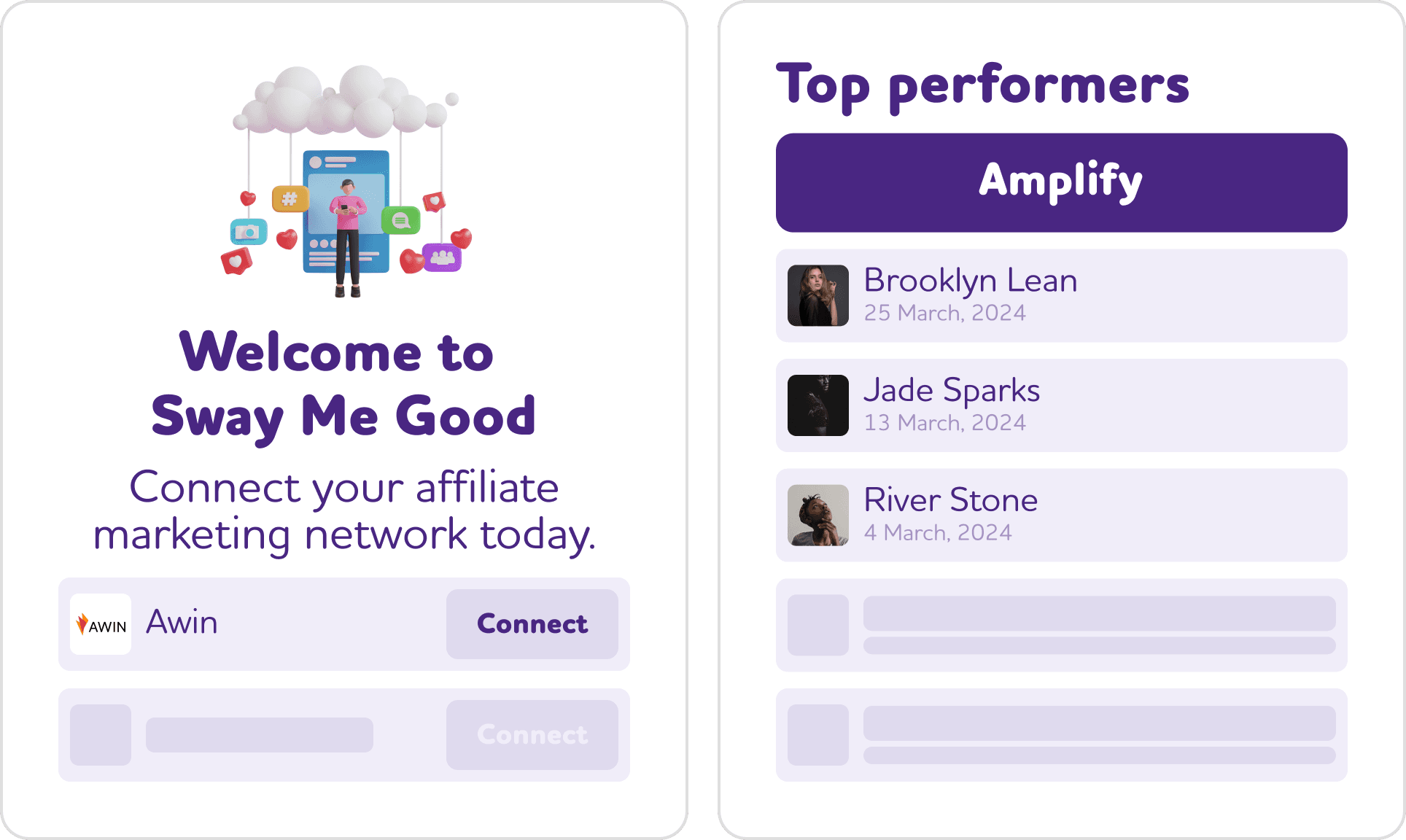1 August, 2024
Influencer marketing is booming. If you’re a marketing or PR agency looking to the future, building a successful influencer marketing service could be one of the hottest tickets to delivering measurable client impacts and long-term agency growth.
But for many agencies, the reality doesn’t match up the hype. Those dreams of significant new revenues become a nightmare of admin and hassle faster than you can search for the next big hashtag.
Here’s what’s going wrong: every manual process, every system put in place that requires manual oversight – it’s all a trap.
Rather than tapping into a goldmine of new opportunities, any attempt to scale your influencer marketing service simply leaves you hitting roadblock after roadblock. You reach their capacity. You can’t grow any further. You’re stuck – and it only gets worse.
Why are agencies so set on scaling influencer marketing?
In short: revenue.
Influencer marketing is growing at speed. The industry is already worth $16.4bn. By 2025, that figure looks set to reach $22.2bn. And 60% of brands with a budget for influencer marketing intend to increase it this year (2024).
Brands know it works. They get bang for their buck. And agencies get their cut, too.
So, why does this promising opportunity turn into a headache for many marketing agencies? The answer lies in how influencer marketing is managed.
Spoiler alert: it’s not pretty.
The typical agency set-up is fatally flawed
In most agencies, just one or two staff manage the entire influencer marketing operation. Often, they’re doing it alongside other roles and responsibilities. It’s very rare that someone’s position is dedicated entirely to influencer marketing.
That’s the first problem.
Second, comes the management. Imagine a mess of spreadsheets tracking ‘To Do’ lists, tasks in progress, and complete projects. Communication spread across emails, DMs, and other project management tools. Throw in most client’s clear preference to work with small influencers, which are harder to find and trickier to deal with, and it’s no wonder the agency team is stressed out.
Here’s what agencies are typically handling:
Account identification: Finding the right influencers who align with the brand’s values, target audience, and budget.
Internal collaboration: Keeping different agency workers up to speed on a raft of different moving parts.
Outreach: Contacting potential influencers, outlining the project, and overcoming initial objections.
Negotiation: Discussing rates and trying to find a common ground between the influencer’s expectations and your client’s budget.
Contracts: Drafting and signing agreements that cover payment terms, deliverables, timelines, compliance with advertising standards, and license ownership.
Shipping: Handling and tracking product deliveries to influencers.
Approvals/feedback: Reviewing content before it goes live and providing feedback where necessary.
Payment: Managing payments to influencers in accordance with each agreed contract, as well as dealing with payment issues with individual bank and PayPal transfers.
Measurement: Tracking campaign performance and reporting results both to agency owners and client teams.
Ongoing comms: Maintaining communication with influencers throughout the campaign.
The consequences of scaling influencer marketing when you’re not ready
Inefficient processes, fragmented performance data, and potentially unreliable influencer partnerships: when everything’s done manually, all of these problems start to compound.
Some (although not all!) agency owners can mistakenly believe that overseeing an influencer marketing campaign will be a relatively light-touch task. But the sheer volume of tasks is overwhelming.
Some of these tasks are tiny, like asking an influencer for their address so you can ship the product. Resolving others can become much more messy, like if an influencer has produced content in the wrong format, or if they’re changed something they weren’t meant to after approvals were confirmed.
48 hours over a five-week period
That’s the average time agencies need to complete a £10,000 campaign involving 10 different influencers, each with 5,000 followers.
When things start to go wrong, the consequences for your agency can be severe.
Reduced productivity becomes the first major internal issue, especially if one client wants to work with a large bank of different influencers. The more influencers are involved, the more complex the coordination becomes. If influencer marketing isn’t a full-time, dedicated role for a specified individual, then the impact on your overall productivity can get even worse.
Poor client service is the next domino to fall. As your team maxes-out its capacity, it’s the quality of client service that inevitably comes under pressure. Delays become more frequent. Attention to detail diminishes. And previously-solid relationships soon begin to fray.
Under-performing campaigns almost inevitably follow, as the impact of incomplete tasks, rushed processes, and a lack of thorough oversight all start to take their toll. As processes begin to fall apart, the quality of influencer content, engagement rates, and the campaign’s overall ROI can all take a hit.
Reputational damage and revenue threats are the icing on this particularly unpleasant cake. Word soon starts to spread when you deliver subpar results and poor client service. Brands talk with each other. And once they hear about your service, it’s going to be a lot more difficult to land new clients or even retain existing ones.
How to fix the headache of influencer marketing
It’s not an easy fix – but it is possible. Start by giving influencer marketing the attention and resources it deserves. It has to become a core part of your service and business strategy.
Budget appropriately
Dedicate specific resources and personnel to manage influencer campaigns. By doing so, you’re giving staff the space to develop the necessary expertise. They’ll also become much more experienced and adept at effectively handling the complexities of influencer marketing.
Develop robust internal processes
Take time to pin down clear, documented processes for managing influencer campaigns. When you plot out every part of the journey, your ability to reduce inefficiencies significantly increases. For example, your processes might include standardised outreach templates to save time and brain space, a centralised platform to store all information related to influencer campaigns (contracts, comms logs, performance metrics, payment records, etc.,), and regular training to keep your team up-to-date with the latest best practices in influencer marketing.
Record and measure every part of your operation
Always be looking for ways to iterate and improve your internal systems, from initial outreach through to final payment. This helps not only with ensuring you meet any compliance obligations, but also in developing internal operations that are capable of scaling with your influencer marketing team.
Focus on long-term influencer relationships
When you find influencers you can trust, make every effort to develop a longstanding relationship built on goodwill from both sides. Having a bank of reliable, proven influencers can save you countless hours on vetting, negotiating, and managing future campaigns. As they work with you more and more, they’ll also develop an even better ability to deliver exactly what you need – on time and on brief.
Leverage technology for maximum impact
The biggest game-changer in scaling influencer marketing is technology. Finding a platform that’s built just for agencies, like Sway Me Good, can unlock several major benefits. These include crucial time-saving automation, end-to-end management, advanced analytics and analysis, and influencer vetting systems that help to maximise your chances of success.
It’s time to get ahead of the pack
Influencer marketing is a huge commercial opportunity for the marketing agencies savvy enough to get their house in order. While your competitors succumb to the carnage of manual influencer marketing management, you can use technology and a structured approach to open opportunities for new business, increased client retention rates, and growing revenues.
Find out more about how Sway Me Good is helping agencies grow with influencer marketing.
QUIZ
How to recognise if you’re stuck in a management nightmare
Admin and Planning. Do you have a clearly defined process for managing every step of an influencer marketing campaign?
Yes (1 point), No (0 points)
Internal collaboration. Does every member of your influencer marketing team know exactly where things stand with every moving task?
Yes (1 point), No (0 points)
Negotiation. Rather than relying on gut feelings, are you using a detailed and well-thought-out framework for valuing each influencer collaboration?
Yes (1 points), No (0 point)
Delivery. Have you ever had an influencer not deliver on time?
Yes (0 points), No (1 point)
Payment. Have you ever been late in paying an influencer after they have completed their work?
Yes (0 points), No (1 point)
Shipping. Has an influencer ever had to complain to you that they were still waiting to receive the product?
Yes (0 point), No (1 points)
Measurement. Have you (or your clients) been disappointed with the results or impact of the influencer marketing campaigns you’ve run?
Yes (0 point), No (1 points)
Scores:
0-2 points: It’s time to get help – fast! You’re stuck in a management nightmare.
3-5 points: You’re surviving, but there’s still room to improve. Do it and you could achieve big growth.
6-7 points: Well done! You’re doing great. Make sure you keep track of the latest tech platforms to keep you ahead of the pack.

New
20 min
The Art of Valuing Influencers
Support for various content types such as articles, blogs, videos, and more. Rich text editor with formatting options for enhanced.

Gad
May 14, 2024

New
20 min
The 20 Best Influencer Marketing Agencies in the UK (2024)
Support for various content types such as articles, blogs, videos, and more. Rich text editor with formatting options for enhanced.

Gad
7 April, 2024

New
20 min
Top 7 Strategies to Scale Influencer Marketing in Agencies
Support for various content types such as articles, blogs, videos, and more. Rich text editor with formatting options for enhanced.

Gad
30 July, 2024






